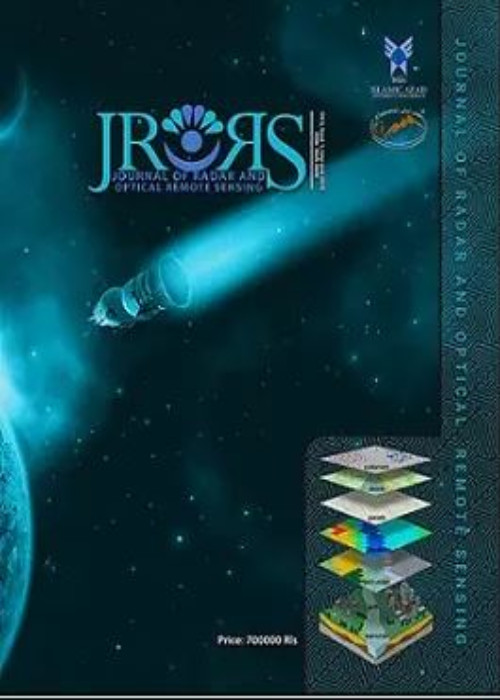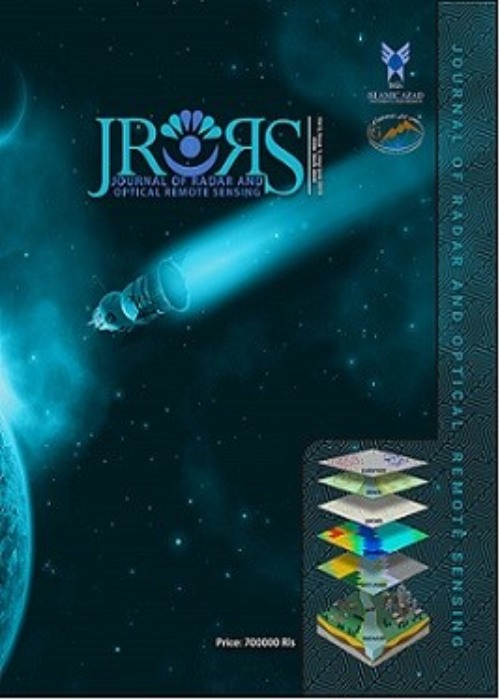فهرست مطالب

Journal of Radar and Optical Remote Sensing
Volume:5 Issue: 2, Spring 2022
- تاریخ انتشار: 1402/01/28
- تعداد عناوین: 4
-
Pages 7-22Natural disasters are phenomena that have always exposed human life in all ages and centuries and had harmful effects. Today's cities in different parts of the world are always exposed to risks caused by natural disasters such as earthquakes due to many reasons such as the type of location, inappropriate physical development, non-compliance with necessary standards and lack of proper management. Assessing the vulnerability of cities against these hazards from different aspects and as one of the factors that determine the level of risk, can lead to the reduction of physical, economic and social damages caused by the occurrence of such incidents. In this research, the 8th region of Tabriz municipality was chosen as the historical and cultural region due to its dilapidated texture, heavy traffic and high and vulnerable population density. The method of research and analysis of the collected information is carried out according to the methods based on the information base and using the Radius program, and three scenarios, according to the fault in the north of Tabriz (scenarios 5, 6 and 7 on the Richter scale) to estimate the damages caused by a possible earthquake in The study was considered.The results indicate that the results of the damages and casualties caused by the earthquake on the considered scenarios indicate that, in the 5 Richter scenario, 20-26% of the buildings will be destroyed, in the 6 Richter scenario, 35-45% of the buildings will be destroyed, and in the 7 Richter scenario, 55-60% Buildings will be destroyed.Keywords: RADIUS model, Earthquake, Damage, Tabriz region 8, Scenario
-
Pages 23-34Prediction and estimation of runoff from snowfall and a quantitative understanding of its various production processes is considered as one of the important topics in hydrology. Therefore, the quantitative and qualitative achievement of it with a systemic approach in this regard is of importance since it forms the basis of studies of construction projects in various fields of development and exploitation in water resources and hydraulic structures and other environmental areas in the watersheds. Regarding the fact that snow cover represents the amount of stored water, so spatial-temporal (spatiotemporal) monitoring of snowmelt runoff is of great importance in hydrological forecasting in this region.The determination of the amount of snowmelt runoff is a function of regional characteristics and the availability of regional data. Therefore, in order to achieve this, ground operation and the creation of a denser network of snow survey stations are needed, which is almost impossible and is not economical. Therefore, in this study, in order to simulate runoff and estimate the share of snowmelt runoff in Marboreh River, simultaneously, optical satellite data and hydrological modelling of runoff are used as advantages. So that, snow product of the 8-day MODIS at 500-meter resolution was used to calculate the snow cover. Finally, the results obtained from runoff simulation by the coefficient of determination and subtracting volume, which were obtained at 0.93 and 3.48 respectively, indicate the high accuracy of the simulation for the area under study.Keywords: runoff, hydrology, Snow cover, Simulation, MODIS
-
Pages 35-44Most underwater intelligent vehicles and marine remote-control vehicles are equipped with optical cameras for underwater imaging. However, due to the properties of water and its impurity, the quality of the images taken by these imaging devices is not good enough, because the water weakens the light, and the deeper the water, the more the intensity of the light will decreases. Since different wavelengths show different behavior in the collision with the water column, processing and study of these wavelengths is very important to obtain the desired image. The spectral signature can be used for underwater applications. In this research, to increase the quality of underwater images, a new method has been introduced to improve image contrast. In this method, first, with structured lighting, different wavelengths are irradiated to the underwater target in a laboratory environment, then underwater images are processed by the proposed algorithm, and finally, a multispectral image is achieved by stacking images with different wavelengths. The results showed the relative superiority of the proposed method over other methods.Keywords: Underwater imaging, Spectral, Underwater target, algorithm
-
Analyzing online participatory planning with a sustainable development approach in Shahinshahr cityPages 45-63The purpose of this research is to analyze participatory planning on the web with a sustainable development approach in the city of Shahin Shahr. In the present research, first the raw layers of Shahinshahr map including regions, districts and urban blocks were prepared from the municipality. In this research, the statistical population is those who have the most connections with urban areas. Based on this and according to the opinion of experts and district managers, trustees who live in Shahin Shahr city and their number is 70 were selected. Then, the address of the place of residence of these people was placed on the city map in Arc GIS software and its various factors were checked. The purpose of writing this research, which is survey and applied, is to analyze the relationship between age, gender, education level, occupation and the suggestions of trustees with the municipality. In the end, it was found that the spatial distribution of the residences of trustees participating in urban programs is not uniform and on the other hand, there is a dependency between the age, gender, level of education and the place of residence of the trustees with the level of their cooperation.Keywords: participatory planning, Sustainable Development, urban management, Shahin Shahr, Arc GIS


